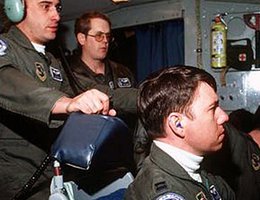
During the Cold War, military planners assumed that the Soviet Union might start a nuclear war at any time. Initially, the attack would have come from bombers flying over the North Pole, which is the shortest route between Russia and the U.S. SAC built a string of radar stations across Alaska, Canada and Scotland to provide about one hour of warning. Then ICBMs — Inter-Continental Ballistic Missiles that could fly from continent to continent in minutes — were developed, and they dropped the warning time to 15 minutes.

Planners had to prepare for the possibility that a nuclear bomb could destroy the underground SAC command center at Offutt with a direct hit. If that happened, the President could not command the thousands of bombers and missiles in SAC’s arsenal. So, SAC developed a way to mirror all of the command and communication functions of the underground center in an airplane. Throughout the Cold War, one of the command planes was in the air at all times, 24 hours a day, 365 days out of the year.
SAC began this mission in 1961, and it was nicknamed "Looking Glass" because the plane mirrored ground-based command, control, and communications systems. From 1961 through 1990, a Looking Glass aircraft, with a full crew of 24, was in the air at all times. Then, with the breakup of the Soviet Union and tough economic times in the U.S., the Looking Glass system was changed.
Instead of having several planes fully manned and one plane in the air at all times, now there are fewer planes and the planes are on alert, ready to fly but not necessarily in the air all the time. The actual plane itself and its equipment has been updated. The old plane was a EC-135 and models served for over 29 years. The new plane is a Navy E-6B. Based on the Boeing 707, the new plane can communicate with the President, underground missile silos, bomber crews, landing fields and even submarines under water. It has a crew of at least 15 and is ready to fly at a moment’s notice.